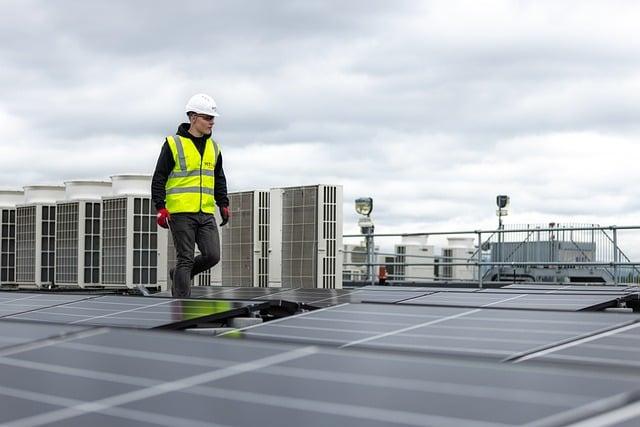In the ever-evolving landscape of renewable energy, a new force is quietly revolutionizing the way we harness the sun’s power. As solar panels continue to dot rooftops and fields across the globe, an unlikely ally is emerging from the realm of digital innovation—blockchain technology. Once synonymous solely with cryptocurrencies, blockchain is now stepping into the spotlight as a catalyst for change in solar energy distribution. By offering unprecedented transparency, efficiency, and decentralization, blockchain is poised to transform how solar energy is produced, traded, and consumed. This article delves into the fascinating intersection of these two groundbreaking technologies, exploring how blockchain is not only illuminating the path to a more sustainable future but also empowering individuals and communities to take control of their energy destinies.
Harnessing Decentralization for Efficient Energy Exchange
In the rapidly evolving landscape of renewable energy, blockchain technology is playing a pivotal role in transforming how solar power is distributed and exchanged. By enabling decentralized energy networks, blockchain offers a revolutionary solution to the limitations of traditional energy grids. It allows for peer-to-peer energy trading, empowering individuals and communities to directly exchange surplus solar energy without the need for intermediaries. This not only reduces costs but also enhances transparency and security, as every transaction is recorded on an immutable ledger.
- Peer-to-peer energy trading: Facilitates direct energy exchange between producers and consumers.
- Enhanced transparency: Immutable records ensure all transactions are visible and verifiable.
- Reduced costs: Eliminates the need for intermediaries, lowering transaction fees.
- Increased security: Blockchain’s decentralized nature reduces the risk of data tampering.
As solar panels become more widespread, the integration of blockchain can create microgrids that are both sustainable and resilient. These networks can respond to local energy demands dynamically, optimizing energy use and reducing wastage. By democratizing energy distribution, blockchain not only supports environmental goals but also fosters energy independence and community empowerment.

Empowering Communities through Transparent Energy Markets
In the ever-evolving landscape of renewable energy, blockchain technology is emerging as a pivotal force in revolutionizing how solar energy is distributed. By leveraging the decentralized nature of blockchain, communities are experiencing a newfound transparency and efficiency in their energy transactions. This transformative technology enables peer-to-peer energy trading, allowing individuals to buy and sell excess solar energy directly with one another. The benefits are manifold:
- Decentralized Control: Removes intermediaries, ensuring that the power remains with the people.
- Real-time Transparency: Provides an immutable ledger of transactions, fostering trust and accountability.
- Cost Efficiency: Reduces transaction fees and operational costs, making solar energy more accessible.
- Enhanced Security: Offers robust protection against data tampering and cyber threats.
These advantages underscore how blockchain is not just a technological upgrade but a paradigm shift towards a more sustainable and equitable energy future. By empowering local communities to manage their own energy resources, blockchain is paving the way for a decentralized energy ecosystem that is both resilient and inclusive.

Enhancing Security and Reliability in Solar Transactions
In the realm of solar energy distribution, blockchain technology is revolutionizing the way transactions are conducted, ensuring both security and reliability. By leveraging the decentralized nature of blockchain, solar transactions become tamper-proof and transparent. This innovative approach not only protects data integrity but also enhances trust among stakeholders. The use of smart contracts in blockchain platforms automates and enforces agreements, reducing the need for intermediaries and minimizing the potential for disputes.
Key benefits of integrating blockchain in solar energy transactions include:
- Immutable records: Every transaction is permanently recorded, making it easy to verify and audit.
- Enhanced transparency: All parties involved can access transaction details in real-time, fostering trust.
- Cost efficiency: Eliminating middlemen reduces transaction costs, making solar energy more accessible.
- Fraud prevention: The decentralized nature of blockchain makes it extremely difficult to alter or forge transaction data.

Innovative Solutions for Seamless Integration of Blockchain and Solar Systems
In the rapidly evolving landscape of renewable energy, blockchain technology is emerging as a game-changer, offering a new level of transparency and efficiency. This innovation is particularly impactful in the solar energy sector, where it addresses key challenges such as energy distribution, transaction transparency, and data management. Blockchain enables a decentralized approach to energy distribution, ensuring that solar power is shared efficiently and equitably among users. By leveraging smart contracts, blockchain automates transactions and validates them in real-time, eliminating the need for intermediaries and reducing costs.
- Enhanced Transparency: Every transaction is recorded on a tamper-proof ledger, fostering trust among participants.
- Improved Efficiency: Decentralized networks streamline the distribution process, minimizing energy loss.
- Scalability: Facilitates the integration of more solar producers and consumers without compromising the system’s integrity.
- Data Security: Ensures that all data exchanges are secure, protecting sensitive information from breaches.
These advancements not only optimize the operational aspects of solar systems but also empower communities by enabling peer-to-peer energy trading. This democratization of energy distribution aligns with global sustainability goals and encourages the widespread adoption of solar technology. As the synergy between blockchain and solar systems continues to evolve, the potential for creating a more sustainable and resilient energy infrastructure becomes increasingly attainable.
The Conclusion
As the sun dips below the horizon, casting long shadows over an ever-evolving landscape, the marriage of blockchain and solar energy stands as a beacon of innovation. This dynamic duo not only illuminates a path towards sustainable energy distribution but also empowers communities to take control of their energy futures. While challenges remain, the potential for a decentralized, transparent, and efficient energy system shines brightly. As we venture into this brave new world, let us remain vigilant and open-minded, harnessing the power of collaboration and technology to illuminate a future where energy flows as freely as sunlight itself. The horizon is vast, and with each sunrise, new possibilities emerge—reminding us that the power to transform our world is, quite literally, in our hands.

































